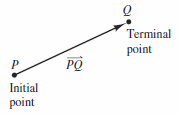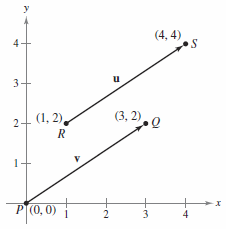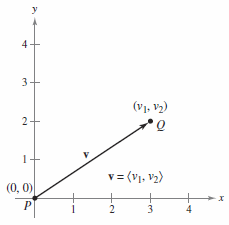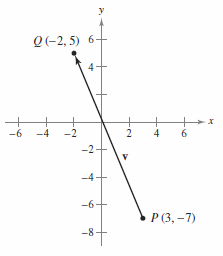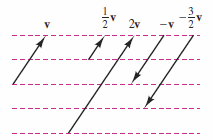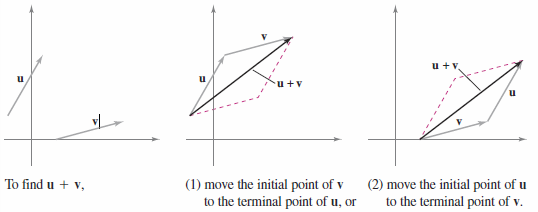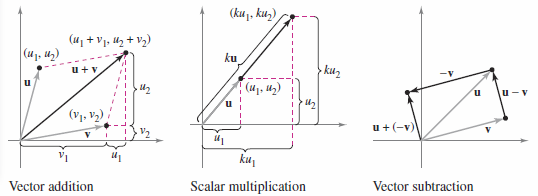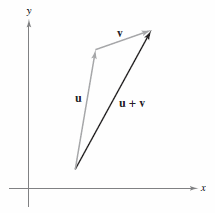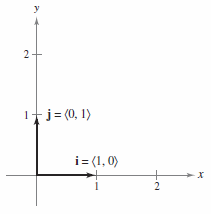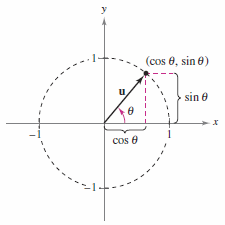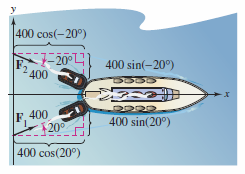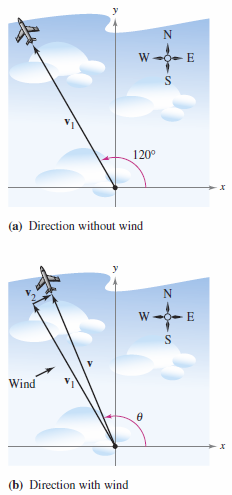Calculus III 11.01 Vectors in Two Dimensions
| Previous | Calculus II |
| Next | Calculus III 11.02 Coordinates and Vectors in Three Dimensions |
Contents
11.1 Vectors[1] in Two Dimensions
- Vector in component form.
- Perform vector operations and interpret the results geometrically.
- Vector as a linear combination in standard unit vectors.
Vector in Component Form
|
|
A vector indicates a quality such as, displacement, velocity or force, that has both magnitude and direction. A vector is often represented by an arrow or a directed line segment. The arrow's length represents the magnitude. The arrow's direction, where the quality is going. The vector is denoted by v, \(v\), or \(\overrightarrow{v}\). A directed line segment representing a vector has a definite initial point \(P\) and a terminal point \(Q\) and its length, or magnitude, is denoted by \(\left \| \overrightarrow{PQ} \right \| \), as shown in Figure 11.1.1. |
Example 11.1.1 Vector Represented as a Directed Line Segment
|
|
Let v be represented by a directed line segment from (0,0) to (3,2). Let u be represented by the directed line segment from (1,2) to (4,4). Show that v and u are equivalent.
Both line segments have the same direction, because they have the same slope relative to the \(x\)-axis.
Because \(\overrightarrow{PQ}\) and \(\overrightarrow{RS}\) have the same length and direction, both vectors are equivalent. |
Definition 11.1.1 Vector in Component Form on a Plane
|
|
If v is a vector on a plane whose initial point is the origin and whose terminal point is \((v_{1},v_{2})\), then the component form for v is
as shown in Figure 11.1.2. |
Example 11.1.2 Vector Length in Component Form
|
|
Find the component form and length for the vector v that has initial point (3,-7) and terminal point (-2,5).
and
Therefore, \( \textbf{v}= \left \langle -5,12 \right \rangle\), and v's length is
|
Example 11.1.2.1 Find the Terminal Point
Find a terminal point, given \( \textbf{v}= \left \langle 4,-9 \right \rangle \); Initial point: (5,3).
Solution Add the vector coordinates to the initial point coordinates to find the terminal point.
- \( (4 + 5, -9 + 3) = (9,-6) \)
The terminal point is (9,-6).
Vector Operations
Definition 11.1.2 Vector Addition and Scalar Multiplication
|
|
Let \(\mathbf{u}=\left \langle u_{1},u_{2} \right \rangle \) and \(\mathbf{v}=\left \langle v_{1},v_{2} \right \rangle \) be vectors and let \(c\) be a scalar. |
Multiplying a vector v by a scalar \(c\) creates a new vector \(c\)v that is \(|c|\) times longer, as shown in Figure 11.1.3. If \(c\) is positive, \(c\)v has the same direction as v. If \(c\) is negative, then \(c\)v has the opposite direction as v. Adding two vectors starts by joining the terminal point for one with the initial point for the other, as shown in Figure 11.1.4(1). The vector u+v, the resultant vector, is the diagonal for a parallelogram having u and v as adjacent sides. Reversing the order to v+u produces the same resultant vector, as shown in Figure 11.1.4.(2).
Vector addition, scalar multiplication, and vector subtraction are shown from left to right in Figure 11.1.5. Note that u-v produces a rectangle.
Example 11.1.3 Vector Operations
For \(v=\left \langle -2,5 \right \rangle\) and \(w=\left \langle 3,4 \right \rangle\) find each vector.
a. 1/2v
b. w-v
c. v+2w
Solution
a. \(\frac{1}{2}\textbf{v}= \left \langle \frac{1}{2} (-2),\frac{1}{2}(5) \right \rangle = \left \langle -1,\frac{5}{2} \right \rangle \)
b. \(\textbf{w}-\textbf{v}= \left \langle w_{1}-v_{1}, w_{2}-v_{2}\right \rangle = \left \langle 3-(-2),4-5 \right \rangle=\left \langle 5,-1 \right \rangle\)
c. Using \( 2\textbf{w} = \left \langle 6,8 \right \rangle\) yields,
| \( \textbf{v} + 2\textbf{w}\) | \(=\left \langle -2,5 \right \rangle +\left \langle 6,8 \right \rangle \) |
| \(=\left \langle -2+6,5+8 \right \rangle \) | |
| \(=\left \langle 4,13 \right \rangle \) |
Theorem 11.1.1 Vector Operation Properties
Any vector set with an accompanying scalar set that satisfies the eight properties is a vector space.[2] The eight properties are called the vector space axioms. Since a set can have one member, any vector on a plane forms a vector space.
Let u, v, and w be vectors on a plane. Let \(c\) and \(d\) be scalars.
| \( \textbf{1.}\: \textbf{u}+\textbf{v}= \textbf{v}+\textbf{u} \) | Commutative Property |
| \( \textbf{2.}\: (\textbf{u}+\textbf{v}) +\textbf{w} = \textbf{u}+(\textbf{v} +\textbf{w}) \) | Associative Property |
| \( \textbf{3.}\: \textbf{u}+0=\textbf{u} \) | Additive Identity Property |
| \( \textbf{4.}\: \textbf{u}+(-\textbf{u})=0 \) | Additive Inverse Property |
| \( \textbf{5.}\: c(d\textbf{u}) = (cd)\textbf{u} \) | |
| \( \textbf{6.}\: (c+d)\textbf{u}=c\textbf{u}+d\textbf{u} \) | Distributive Property |
| \( \textbf{7.}\: c(\textbf{u}+\textbf{v}) = c\textbf{u} + c\textbf{v} \) | Distributive Property |
| \( \textbf{8.}\: 1(\textbf{u}) = \textbf{u}, 0(\textbf{u}) = 0 \) |
Proof The Associative Property(2) proof uses the Associative Property for real numbers.
| \((\textbf{u}+\textbf{v}) +\textbf{w} \) | \(= [\left \langle u_{1},u_{2} \right \rangle + \left \langle v_{1},v_{2} \right \rangle] + \left \langle w_{1},w_{2} \right \rangle\) |
| \(= \left \langle u_{1}+v_{1},u_{2} + v_{2}\right \rangle + \left \langle w_{1},w_{2} \right \rangle\) | |
| \(= \left \langle (u_{1}+v_{1})+w_{1},(u_{2} + v_{2}) + w_{2} \right \rangle\) | |
| \(= \left \langle u_{1}+(v_{1}+w_{1}),u_{2} + (v_{2} + w_{2}) \right \rangle\) | |
| \(= \left \langle u_{1},u_{2} \right \rangle + \left \langle v_{1}+w_{1},v_{2} + w_{2} \right \rangle\) | |
| \(= \textbf{u}+(\textbf{v} +\textbf{w}) \) |
The other properties can be proved in a similar manner.
Theorem 11.1.2 Scalar Multiple Length
Let v be a vector and let \(c\) be a scalar. Then
- $$\left \| c\textbf{v} \right \| = |c|\left \| \textbf{v} \right \|\:\:\:\: \color{red}{|c|\text{ is the absolute value for }c} $$
Proof Because \(c\textbf{v}= \left \langle cv_{1},cv_{2} \right \rangle\)
| \(\left\|c\textbf{v}\right\|\) | \(=\left\|\left\langle cv_{1},cv_{2}\right\rangle\right\|\) |
| \(=\sqrt{ (cv_{1})^{2}+(cv_{2})^{2} } \) | |
| \(= \sqrt{ c^{2}(v_{1})^{2}+c^{2}(v_{2})^{2} } \) | |
| \(= \sqrt{ c^{2}((v_{1})^{2}+(v_{2})^{2}) } \) | |
| \(=|c|\sqrt{(v_{1})^{2}+(v_{2})^{2}} \) | |
| \(=|c|\left \| \textbf{v} \right \| \) |
Theorem 11.1.3 Unit Vector in the v Direction
In many vector applications a unit vector with the same direction as a given vector is useful for measurement.
If v is a nonzero vector on a plane, then the vector
- $$\textbf{u}=\frac{\textbf{v}}{ \left \| \textbf{v} \right \|} = \frac{1}{\left \| \textbf{v} \right \|}\textbf{v}$$
has length 1 and the same direction as v.
Proof Because \(1/\left \| \textbf{v} \right \| \) is positive and \(\textbf{u} = (1/\left \| \textbf{v} \right \|)\textbf{v} \) u has the same direction as v. To see that \(\left \| \textbf{u} \right \| = 1 \), note that
- $$\left \| \textbf{u} \right \| = \left \| \left( \frac{1}{ \left \| \textbf{v} \right \| } \right) \textbf{v} \right \| = \left | \frac{1}{\left \| \textbf{v} \right \|} \right | \left \| \textbf{v} \right \|=\frac{1}{\left \| \textbf{v} \right \|}\left \| \textbf{v} \right \| = 1$$
Therefore, u has length 1 and the same direction as v. The vector u is called the unit vector in v's direction. The process for multiplying v by \(1/\left \| \textbf{v} \right \| \) is called normalizing v.
Example 11.1.4 Finding a Unit Vector
Find a unit vector for \( \textbf{v} = \left \langle -2,5 \right \rangle\) and verify that it has length 1.
Solution From Theorem 11.1.3, the unit vector for v is
| $$ \frac{\textbf{v}}{\left \| \textbf{v} \right \|} $$ | $$= \frac{ \left \langle -2,5 \right \rangle }{\sqrt{(-2)^{2}+(5)^{2}}}$$ |
| $$=\frac{1}{\sqrt{29}}\left \langle -2,5 \right \rangle $$ | |
| $$= \left \langle \frac{-2}{\sqrt{29}},\frac{5}{\sqrt{29}} \right \rangle$$ | |
| Substitute this into the proof for Theorem 11.1.2 yields. | |
| $$= \sqrt{ \left(\frac{-2}{\sqrt{29}}\right)^{2} + \left(\frac{5}{\sqrt{29}}\right)^{2} }$$ | |
| $$= \sqrt{ \frac{4}{29}+\frac{25}{29}} $$ | |
| $$= \sqrt{\frac{29}{29}} = 1$$ | |
|
|
In general the sum for two vectors has a different length than each vector length added separately. The vectors u and v are two sides on a triangle with the third side having length \(\left \| \textbf{u} + \textbf{v} \right \| \), and
as shown in Figure 11.1.6. This result is called the triangle inequality for vectors. Triangle equality occurs only when the vectors u and v have the same direction. |
Standard Unit Vectors
|
|
The unit vectors \(\left \langle 1,0 \right \rangle \) and \(\left \langle 0,1 \right \rangle \) are called the standard unit vectors in the plane and are denoted by
as shown in Figure 11.1.7. These vectors can be used to represent any vector uniquely, as follows.
The vector \( \textbf{v} = v_{1}\textbf{i} + v_{2}\:\textbf{j} \) is called a linear combination for i and j. The scalars \(v_{1}\) and \(v_{2}\) are called the horizontal and vertical components for v. Example 11.1.5 Writing Unit Vectors in a Linear CombinationLet u be the vector with initial point \((2,-5)\) and terminal point \((-1,3)\). Let \(\textbf{v} = 2\textbf{i} -\textbf{j} \). Write each vector as a linear combination for i and j.
|
Example 11.1.6 Describing a Vector with a Given Magnitude and Direction
The vector v and a magnitude equal to three and an angle equal to \(30^{\circ} = \pi /6 \) with the positive \(x\)-axis. Describe v as a linear combination with the unit vectors i and j.
Solution
If u is a unit vector and \(\theta\) is an angle, measured counterclockwise, from the positive \(x\)-axis to u, then the terminal point for u lies on the unit circle. This is described by
- \(\textbf{u}= \left \langle \cos \theta, \sin \theta \right \rangle = \cos \theta\:\textbf{i} +\sin \theta \:\textbf{j} \:\:\:\: \color{red}{\text{Unit vector}}\)
as shown in Figure 11.1.8. For any other nonzero vector v making an angle \(\theta\) with the positive \(x\)-axis has the same direction as u and can be described as
- \( \textbf{v}= \left \| \textbf{v} \right \| \left \langle \cos \theta, \sin \theta \right \rangle = \left \| \textbf{v} \right \|\cos \theta\:\textbf{i} + \left \| \textbf{v} \right \| \sin \theta \:\textbf{j}\).
Because the angle between v and the positive \(x\)-axis is \(\theta = \pi /6 \) the vector can be described as
| \(\textbf{v} \) | \(=\left \| \textbf{v} \right \|\cos \theta\:\textbf{i} + \left \| \textbf{v} \right \| \sin \theta \:\textbf{j}\). |
| $$=3 \cos \frac{\pi}{6}\textbf{i} + 3 \sin \frac{\pi}{6}\textbf{j} $$ | |
| $$= \frac{3\sqrt{3}}{2}\textbf{i} + \frac{3}{2}\textbf{j} $$ |
Example 11.1.7 Finding the Resultant Force
|
|
A vector can represent force because it has both magnitude and direction. If two or more forces are acting on an object, then the resultant force on the object is the sum for all the vector forces. Two tugboats are pushing an ocean liner, as shown in Figure 11.1.8. Each boat is exerting 400 pounds along different vectors. What is the resultant force on the ocean liner?
The resultant force on the ocean liner is
The resultant force on the ocean liner is approximately 752 pounds along the positive \(x\)-axis. |
Example 11.1.8 Finding a Velocity
|
|
In surveying and navigation, a bearing is a direction that measures the acute angle that a path or line of sight makes with a fixed north-south line. In air navigation bearings are measured in degrees clockwise from north. Due North is 0°, due East is 90°, due South is 180°, and due West is 270°. An airplane is traveling at 500 miles per hour bearing 330°, as shown in Figure 11.1.10(a). It encounters a wind at 70 miles per hour from the N.E., as shown in Figure 11.1.10(b). What is the resultant speed and direction for the airplane?
The wind's velocity is described by the vector
The resultant velocity for the airplane and the wind is
Plugging this result into Theorem 1.1.2 yields
The airplane's new vector, as altered by the wind, is \(\approx\) 522.5 miles per hour at 112.6° to the positive \(x\)-axis. |
Internal Links
Parent Article: Calculus III 11 Vectors and Spacial Geometry
